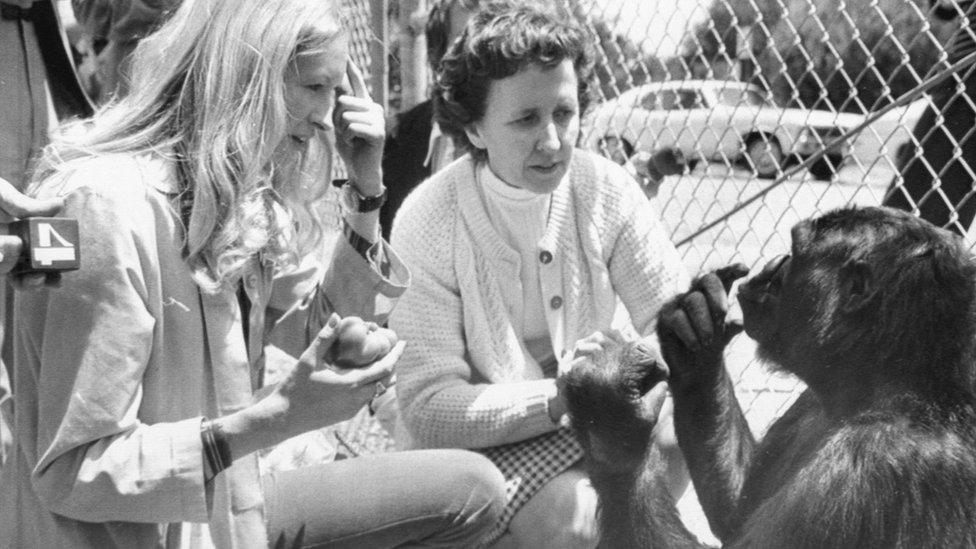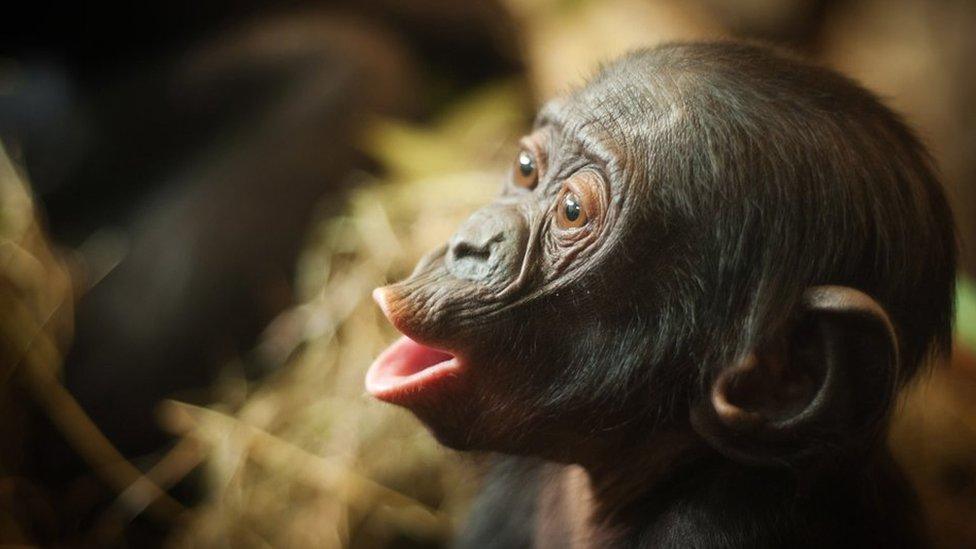Koko: Gorilla death coverage rekindles language debate
- Published

Koko, the celebrated western lowland gorilla, died at the age of 46 this week. Many people paid tributes to her by praising her signing skills. She's famous for her signing skills, but all is not what it seems.
Her death resonated with many people, with videos showing her communicating with her trainers being shared widely on social media.
In many obituaries, it was claimed that she "mastered" American Sign Language, using over 1,000 signs, but some experts said the headlines praising her sign language skills were rather inaccurate.
Allow X content?
This article contains content provided by X. We ask for your permission before anything is loaded, as they may be using cookies and other technologies. You may want to read X’s cookie policy, external and privacy policy, external before accepting. To view this content choose ‘accept and continue’.
When she was about 12 months old, animal psychologist Francine "Penny" Patterson started to train her to use a version of American Sign Language. Her instructors said Koko used it to convey thoughts and feelings.
Ms Patterson and her researchers documented that the gorilla understood some 2,000 words of spoken English. The abilities of the gorilla apparently to understand spoken English were documented by Ms Patterson and her researchers.
However, sceptical linguists and scientists questioned Patterson's methods. They also debated how much of Koko's communication actually came from herself or how much we projected ourselves onto her.
When Koko's death was announced, many news organisations, including the BBC, wrote headlines such as "Koko: Gorilla who mastered sign language" and "Koko, famed gorilla that learned sign language".
Many social media users complimented her on her supposed language skills, but not all were convinced that she was actually using sign language. However, many people were impressed by her communication prowess.
Allow X content?
This article contains content provided by X. We ask for your permission before anything is loaded, as they may be using cookies and other technologies. You may want to read X’s cookie policy, external and privacy policy, external before accepting. To view this content choose ‘accept and continue’.

Allow X content?
This article contains content provided by X. We ask for your permission before anything is loaded, as they may be using cookies and other technologies. You may want to read X’s cookie policy, external and privacy policy, external before accepting. To view this content choose ‘accept and continue’.
University of Birmingham's Dr Adam Schembri said the headlines need "to be worded with care, external to avoid crating a misleading impression." He said Koko "did not learn sign language", but she mastered a number of modified American Sign Language signs, which is not the same as American Sign Language.
Allow X content?
This article contains content provided by X. We ask for your permission before anything is loaded, as they may be using cookies and other technologies. You may want to read X’s cookie policy, external and privacy policy, external before accepting. To view this content choose ‘accept and continue’.
Marcus Perlman, a linguist, who studied Koko as part of his research into ape communication, weighed in.
Allow X content?
This article contains content provided by X. We ask for your permission before anything is loaded, as they may be using cookies and other technologies. You may want to read X’s cookie policy, external and privacy policy, external before accepting. To view this content choose ‘accept and continue’.
Gerardo Ortega, a sign language researcher, said Koko never mastered sign language, external. He tweeted: "At most she ritualised the use of some signs about the here and now and used them only after trainer promoted her."
Allow X content?
This article contains content provided by X. We ask for your permission before anything is loaded, as they may be using cookies and other technologies. You may want to read X’s cookie policy, external and privacy policy, external before accepting. To view this content choose ‘accept and continue’.
However, some sign language users see things differently, especially some people who said she inspired them to learn sign language.
Allow X content?
This article contains content provided by X. We ask for your permission before anything is loaded, as they may be using cookies and other technologies. You may want to read X’s cookie policy, external and privacy policy, external before accepting. To view this content choose ‘accept and continue’.

Allow X content?
This article contains content provided by X. We ask for your permission before anything is loaded, as they may be using cookies and other technologies. You may want to read X’s cookie policy, external and privacy policy, external before accepting. To view this content choose ‘accept and continue’.
Speaking to BBC News, Prof Graham Turner of Heriot Watt University, said: "Serious efforts to teach apes some signing began in the 1960s with researchers attempting to teach individual signs derived from American Sign Language (ASL). And the apes did learn to use some hand gestures in this way.
"But it is a distortion to imply that Koko or any ape has ever learned to use a natural signed language like a human being."
Prof Turner said: "These languages use the face, body and hands in an integrated way, exploiting their multidimensional, spatial medium through the layering of simultaneous and extremely precise visual elements. So communication in ASL or any such signed language entails acquiring command of a far more complex system of linguistic expression.
"That system must also permit the creation of new patterns and sequences - formed within the constraints of the system - for any context that may arise. With this kind of appreciation of sign language structure it is plain that 'signing' apes have never proven capable of displaying grammatical competence comparable to human fluency.
"Although the apes can use two or three signs in a sequence, close inspection of filmed data has repeatedly shown trainers prompting them, and then questionably interpreting separate responses as signed sentences."
Whether she used sign language or not, her command of gestures was extraordinary for a gorilla. She connected not only with some humans but also with animals, especially kittens.
- Published2 June 2015
